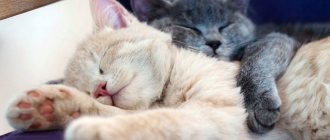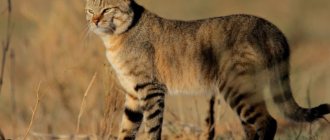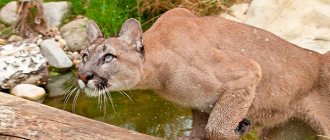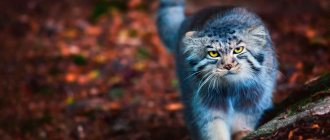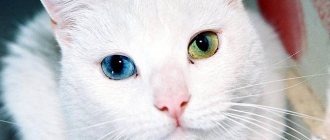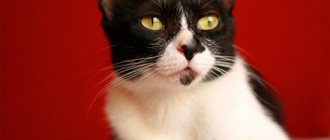If you look into history, you can also find images of cats in rock paintings. There is a version that the ancient Egyptians tamed wild animals from the cat family. The coexistence of cats and humans began about 10-15 thousand years ago. According to one version, the ancestor of the first domestic cat was the North African steppe cat; it was domesticated in Nubia, after which the animals began to be imported to Egypt and Asia. It was there that interbreeding with wild Bengal species occurred.
Details of the distribution of cats around the globe
Ancient Egypt is officially considered the birthplace of cats. There was even a cult of cats. These animals were worshiped as they were considered a symbol of the Sun and fertility. By an imperial decree in 390, the cult of the goddess Bastet, depicted as a woman with a cat's head and the embodiment of female beauty, joy, fertility, hearth and cats, was prohibited. Since then, pets have ceased to be an object of worship in temples, but continued to exist peacefully in the homes of Egyptians.
Cats quickly spread throughout the world. The Phoenicians took part in this process, regularly making sea voyages. They always took cats on board with them to protect their provisions from mice and rats. The cats that came to Greece deserved special gratitude from the local population. They helped cope with hordes of rats and mice, which is why they were made a symbol of the Spartacus uprising.
The cat's travels around the world continued, the next country was Georgia, and then they conquered the entire European market. The remains of a domesticated cat found in Britain date back to the 4th century BC. A law was even passed on the issue of keeping pets in houses and their protection, after which animals settled next to people in dwellings and monasteries.
Information about cats that settled in Rus' dates back to the 7th century BC. They were brought to Russian lands by warriors and traders. Animals were revered not only by ordinary people, they were under church protection. Not everyone could buy a kitten, because the price for a pet was prohibitively high.
Historical events of the Middle Ages
Cats quickly multiplied all over the earth, so they lost their privileged position. The clergy changed their minds about pets, and active persecution of cats began. Killing and torturing animals became commonplace. Even in England, where cats were adored, they were actively burned at the stake, considered the personification of evil spirits.
In America, people who kept pet cats were considered minions of evil forces, so they had to choose: keep the cat and be bullied, or kick out the pet and suffer from mouse attacks.
Renaissance
During the Renaissance, cats began to re-conquer human habitations. In the 18th century, cat baiting stopped and people began holding exhibitions of these animals. The creation of new breeds with certain characteristics necessary for humans was initiated.
Nowadays pets are very popular. Almost every fourth family has one or even several kittens. Thanks to breeding work, dozens of new breeds have been developed, so purchasing a suitable pet for the family will not be difficult.
Where did Siamese cats come from?
The Siamese cat, which many associate with a demon, originated in Thailand between 1350 and 1750. This is a purebred animal, and man made no effort to breed the breed.
The first Siamese are described in writings from the 19th century. It says that these cats were considered sacred animals and were kept in Buddhist temples. Only priests and royal families were allowed to have them.
Today everyone can afford this breed of pet; they are bred in nurseries.
Theory of the origin of cats
Cats belong to the carnivorous mammals of the cat family. According to scientists, approximately 600 million individuals have been domesticated in the modern world. The history of modern cats is closely connected with forest and steppe representatives of the cat family. The term cat itself comes from the Latin “cattus”; in the Old Russian language there was a name “kotka”.
There are two versions about the origin of cats. According to one of the biblical legends, rodents appeared on Noah’s Ark during the Flood, which other animals could not cope with. Then the lions gave birth to cats, which, thanks to their small size and dexterity, were able to catch all the rats and mice.
According to the second version, the first wild cats inhabited the planet more than 60 thousand years ago. The ancestor of the cat family is considered to be the Fossu, an ancient species that lived in Madagascar. There is another scientific opinion that has a right to exist - the ancestor of modern seals was Proailurus, which existed approximately 25 million years ago on the territory of Eurasia.
The weight of Proailurus was about 9 kg, the animal had a dense build, short limbs and an elongated body with a long tail. Sharp, half-retractable claws made it possible to spend most of the time not on the ground, but in trees. This way of life helped to escape from large predators.
It is believed that many lineages of cats, including saber-tooths, originated from Proailurus. He was the progenitor of a suborder including hyenas, civets and cats of prey.
When a cat became a man's friend
Compared to dogs, whose domestication occurred at the border of the Upper Neolithic and Mesolithic, the domestication of cats dates back to a later date. This is due to the fact that for a long time people did not pay attention to these small animals, considering them only an object for hunting.
Interest in small predators began to appear when the lifestyle became more sedentary. When man learned to create reserves of grain, it turned out that numerous rodents were not averse to eating them. Scientists believe that farming pushed people to domesticate wild cats to protect their territories and supplies from rodents.
The unclear history of the origin of cats makes it difficult to study the processes of domestication of these animals. The process of domestication of wild ancestors is believed to have begun in Nubia.
The North African cat, which has an easy-going disposition, began to live near human habitation approximately 2 thousand years BC. Once in border Egypt, these fluffy semi-wild creatures became iconic animals for many millennia.
Genetic studies of the DNA of a modern cat have made it possible to hypothesize that the center of domestication of these animals is the territory of modern Israel, Iraq and Jordan. In addition to killing mice and rodents, wild cats also hunted snakes, which was very important for residents of the Asian region.
The results of archaeological excavations also support this theory. Scientists have found the remains of cats in the city of Jericho, dating back to the 5th - 6th millennium BC. It was these lands that began to be successfully developed by farmers and can rightfully be considered the center of domestication of wild animals.
Modern cat breeds
Eye color, coat color and length, body structure, head and tail, character - all these characteristics are taken into account when creating the breed. The World Cat Federation (WCF) adheres to the following classification of cat breeds:
- long-haired;
- with medium length hair (semi-longhair);
- short-haired;
- Shorthaired Siamese-Oriental.
The International Organization for the Breeding and Selection of New Breeds of Cats (FIFe) uses a slightly different classification:
- exotics and Persians;
- semi-longhaired;
- shorthaired, including Somalia;
- eastern (orientals).
The concept of a “breed” of cats appeared not so long ago. Even 200 years ago, these pets were not classified according to breed characteristics.
It is customary to refer to purebred pets as having certain external characteristics and a unique character.
With the development of breeding work, animals of a certain breed began to be issued documents confirming their belonging and compliance with the standards of this breed. Pets obtained as a result of crossing purebred parents can obtain a pedigree. The document indicates not only parents, but also other ancestors (up to the 4th generation).
There are very few purebred cats all over the world (about 3%), all other pets are classified as mongrel, but this makes them no less revered by humans. Only individuals who do not have breed defects are allowed to participate in exhibitions according to the show class. But individuals without a pedigree are allowed to be shown only in the pet category.
Creodont cat's ancestors
This is the official version of the origin of the cat. Scientists believe that the first cats were evil creodonts. They ate meat, cruelly dealing with their next prey, and were much larger in size than the tiger we know, and even more so than the beloved domestic cat. All scientists adhere to this version, although they do not have direct evidence of it. When children ask where cats came from, they are often told this version.
Creodonts inhabited the vastness of the Earth fifty million years ago. These were dangerous predators that terrified all representatives of the fauna. Everything that moved, ran away, and chewed was eaten.
Many years later, thanks to evolution and amazing transformations, the first lions, saber-toothed tigers, and cheetahs appeared. And after thousands of years, we were able to see a cat that we can take home with pleasure and without fear. But this is too simple an answer to the question of where domestic cats came from. Let's look into mythology?
Stories of the appearance of purebred cats
Cat breeds appeared thanks to the selective work of people, but certain species arose due to gene mutations. There are also native breeds of pets, that is, those that appeared in isolated areas, they are classified as naturally formed breeds:
- Siberian;
- Angora;
- Thai.
Some breeds are hybrid. They arose as a result of the mating of wild and domestic individuals. The Bengal cat is usually classified as a hybrid cat; Asian leopard wild cats and domesticated pets participated in the creation of the breed.
Messengers from distant stars
No matter how funny it may seem, there are many great minds who are completely sure that cats literally fell to Earth from the Moon!
Plotinus (Neoplatonist philosopher) was even able to argue his opinion about the origin of cats. He wrote in the Ennead irrefutable evidence specifically in favor of the Moon. In his opinion, cats are creatures of this satellite because they see well in the dark, are active at night, and their behavior depends on the phases of the moon.
According to Augustine the Blessed, who wrote the work “On the City of God,” cats are sent to us from those very distant stars where the human soul resides after death. The Almighty only showed them the way there and back, and they can communicate with spirits. But it’s not for nothing that people are sure that cats get along well with ghosts and see them, which is not given to humans.
Old cats and problems associated with them
Health, Cat Care
Like people, animals acquire some problems with age, which means they require more attention and quality care. We want to look at a few nuances that will help you understand that...
Read more
Where did Sphynx cats come from?
In fact, there are a huge number of sphinx breeds and not all are popular. Where did hairless cats come from? This question torments many people. Descriptions of hairless cats have been available since ancient times; the Aztecs could have been their owners.
At all times, hairless kittens have been born on the territory of our planet. They were of no interest to people and were simply destroyed. A resident of Canada was the first to decide to breed the breed when, in 1966, he discovered a hairless cat in his cat’s litter. The baby was named Prunt and later brought together with his mother. Both normal and hairless kittens were born again. Then hairless cats and female cats were bred until shaggy creatures completely disappeared from the litters. This is how the now popular sphinxes appeared, and they owe their origin to an ordinary mutation.
What if the legend is true, and once upon a time hairless alien cats visited our Earth, and now cats give birth to hairless kittens, reminding them of their origin? This will forever remain a secret!
Characteristics of cat breeds
Each breed has its own characteristics, behavior, and habits. Of course, almost all cats can be raised and trained, gradually adapting to the rules established by humans. However, some people get used to it easier, while others require a lot of work. It depends on the character.
The most affectionate cats
Affectionate breeds of cats are very loved by their owners for their tenderness and purring; they happily greet a person from work, lie on their laps for a long time or wake them up by purring softly in the ear. Such displays of love, and sometimes even care, can be expected from the following breeds:
- bambino;
- British Longhair;
- Burmese;
- Nibelung;
- chausie;
- Chartreuse (Carthusian);
- ragamuffin.
These breeds have a soft, calm character, and sometimes even phlegmatic. Even a small child can play with them without fear of getting scratched. And manifestations of aggression are completely atypical for them and rather an exception to the rule.
Bambino cat.
British blue longhair cat.
Burmese cat.
Nibelung cat.
Chausie cat.
Ragamuffin cat.
Carthusian Chartreuse cat.
Cats similar in character to dogs
Sometimes it is difficult for a family to get a dog for a number of reasons, but it is worth looking for cats with similar characters and habits. They have a proud, independent disposition, are loyal, and very affectionate. Among these, it is worth highlighting the Bengal one. In terms of the degree of love and affection for their owner, they can compete with the smartest dogs. The Tonkinese cat has the same features.
Bengal cat.
Tonkinese cat.
A Turkish Angora dog may notice. She will become a real four-legged friend. She likes to communicate with a person, play with him, even dog games, she is very talkative. They are well trained and follow commands. Usually, among all family members, they distinguish their owner, which makes them very similar to dogs.
Black and white Angora cat.
Savannah can also be a good substitute for a small dog; they like to spend a lot of time outside. Savannah is a mixture of an ordinary domestic cat and a serval, so do not forget about the complex character, which is explained by the presence of wild animal genes.
Savannah plays ball.
The most evil and harmful cat breeds
Typically, a person who wants to get a cat at home wants to see an affectionate pet purring gently on his lap. However, for some cat breeds, this behavior is the exception to the rule. It’s difficult to call them unequivocally evil. Rather, a peculiar character is taken for malice. Difficult temperament and natural harmfulness are most often observed in the following:
- Siamese;
- Mekong Bobtail;
- savannah.
These cats look like cute fluffy creatures, but sometimes the aggressive habits of their distant wild ancestors awaken in them. Sometimes it is difficult for a person to cope with such animals. You should definitely not leave small children alone with them, as they may cause scratches or bites. Neighborhood with domestic rodents and birds can also end badly - the hunter’s instinct will push the animal to go after easy prey.
Top 5 smartest cat breeds
There are a variety of intelligence ratings, one of the most interesting was presented by the Animal Planet TV channel. Journalists, together with scientists, studied the mental abilities of many breeds, and based on the analysis, the smartest cats were determined.
- Sphinx. These cats are able to sense the mood of their owner, are well trained and with effort, they can be taught even complex commands. You should not punish these pets; they have a very sensitive and vulnerable psyche and can become stressed or depressed.
- Siamese-oriental group. This includes Balinese, Bengal, Siamese and other Southeast Asian breeds.
- Munchkin. One of the smallest breeds, but its miniature size harmoniously merges with great mental abilities. These cats are very playful, curious, and affectionate. One of their peculiarities is the desire to hide the objects he likes in secluded places in the apartment.
- Norwegian forest. They have large size, good character, and developed intelligence.
- Maine Coon. The adult individual has an easy-going character, is active and very intelligent.
Such ratings are conditional in nature, since any breed has its “smart guys” and “bad students.” The mental abilities of a yard mongrel cat, whose upbringing has been given a lot of attention from an early age, can significantly exceed its eminent counterparts.
Don Sphynx kittens.
Oriental cat.
Munchkin cat.
Norwegian Forest Cat kittens. Maine Coon cats.
Which cats are the best mousecatchers?
Experts consider outbred cats to be the best hunters. This is fair, since hunting ensures their existence. Genes provide continuity of hunting instincts, as well as physical strength and endurance.
As for purebred cats, it is worth paying attention to aboriginal breeds that were formed by natural conditions, that is, without human intervention in these processes. The Kurilian Bobtail, Russian Blue, and Maine Coon are especially distinguished by their developed skills. Oriental cats, Abyssinians, Thais, and Siamese have good ability to catch mice.
Russian blue cat breed.
Abyssinian cat.
Thai cat color.
What are the dangers of uncontrolled rat reproduction?
In addition to the fact that these large rodents eat and gnaw everything that gets in their way, they are carriers of serious infections. One rodent can have more than a thousand different pathogens in its body. Rats spread plague, typhus, salmonella, leptospirosis, etc. Street rodents can transmit diseases not only if they bite a person. They spread viruses through urine and feces. Some diseases they carry are even transmitted through the air.
Another reason why uncontrolled reproduction of rats is dangerous is their gluttony. They happily eat grain in barns and any other food. They are omnivores. Their diet can include any food, garbage and even animal remains. Their sharp teeth can even chew brick, cement and lead.
People still haven't come up with a sufficiently effective rat poison. This is because these smart rodents easily adapt to it. If an animal in a population dies from poison, then others remember this substance and avoid it. They are also able to develop natural immunity to poisons.
This is why cats are so important to humans. And most of us keep these cute furry predators at home. And scientists conduct experiments with them, trying to better understand these mysterious creatures, which sometimes smile skeptically with a Duchenne smile or curl up into a warm ball at the feet of the owner.
The connection between the domestic cat and its “wild relatives”
Cats can be domestic or wild. The wild cat family includes 37 species; they are considered the most advanced predators of all land animals. These include the puma (America), jaguar (Central and South America), lion (Africa), tiger (Asia), cheetah (Africa and western Asia), snow leopard (Himalayas), lynx (Europe) and others. Large representatives can be dangerous even to humans.
People started breeding new breeds of domestic cats relatively recently - about 150 years ago. There are now more than 100 cat breeds. Among them, the most famous long-haired ones are Persian and Maine Coons; shorthaired - Siamese, British; hairless cats - sphinxes and others.
But so far there are much fewer purebred cats than the usual and beloved “Murok” and “Vasek”. Felines belong to the family of mammals, the order of carnivores. All types of cats have a small head, and a very slender, graceful body. The legs are not high, but powerful. The claws are fully or partially retractable, only the cheetah cannot retract. Most have a long tail, but the lynx has a short tail.
The sizes of cats range from small (20 cm at the withers, for example, domestic cats) to large (120 cm - tiger, lion). The best developed sense organs are hearing and vision. The lifestyle is largely nocturnal and twilight. Food includes fish, birds, reptiles, mammals, and sometimes insects. Most species hunt alone (cheetahs, tigers) or as a whole brood (lions in a pride).
Scientists have found that the tiger and the domestic cat are closest relatives; their common ancestor lived on earth about 11 million years ago. For comparison, the common ancestor of humans and apes lived approximately 12 million years ago. Scientists have concluded that “Tigers are just big domestic cats...” since the differences between the genomes of a tiger and a cat are only 4.4%.

